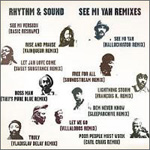|
|
 |
Dusted Reviews
Artist: Rhythm & Sound Album: See Mi Yah Remixes Label: Burial Mix Review date: Aug. 20, 2006 |

|
|
|
 |
When the vastly influential techno duo of Moritz von Oswald and Mark Ernestus want to get their dub on, they call themselves Rhythm & Sound. Though dub-reggae has informed many of the Berlinites’ pioneering projects, including their classic Basic Channel output, the moniker Rhythm & Sound represents their most overt and reverential interactions with the music. It is fitting, then, that it is under the Rhythm & Sound heading that they chose to tackle one of reggae’s most peculiar traditions, the “one-rhythm-album,” with 2005’s See Mi Yah. A common assumption regarding the rhythm album, one supported by the dancehall emcee merry-go-round that is the Greensleeves rhythm album series, is that it doesn’t work as a complete listening experience — it simply offers a greater choice of vocal versions to DJs. In the hands of Rhythm & Sound, however, the rhythm album — See Mi Yah in particular — becomes a celebration of the nuances in a dub producer’s craft, with subtle alterations, additions and subtractions
The choice to issue remixes of See Mi Yah, as Rhythm & Sound did this year with four 12-inch singles on the Burial Mix label (now compiled on CD as See Mi Yah Remixes), is at once an expected and unprecedented development: expected because the inherent monotony of the rhythm album begs for varied, thoughtful remixing, and unprecedented because Mark and Moritz have been loath to commission remixes of their material, much less endorse a project of this magnitude. Enlisting a mixed company of techno-stalwarts, old collaborators, and new talent, See Mi Yah Remixes sees the singular vision of the original album both reiterated and expanded.
Mark and Moritz’s obsession with dub belies a career-long fascination with minimalism. Thus, it is no surprise that the more subtle reworks of See Mi Yah Remixes are attributed to them or their close associates. Long-time Basic Channel ally Vainqueur reinterprets “Rise and Praise” with gently pulsating synth-waves, propelled forward by the simplest of bass drum kicks. Adopting their Basic Channel alias and performing one of their famed “Basic Reshapes,” Rhythm & Sound up the reductive ante by paring down the original instrumental to its rhythmic foundations, allowing the melody components only brief moments of audibility above the house rhythms. Both tracks stake out the Rhythm & Sound territory in meticulously minimal soundscapes, a last vestige of Mark and Moritz’s calculated propriety.
Fortunately, the recruited artists do not attempt to follow suit; instead they eschew the minimalist doctrine of the Basic Channel school and come up with more interesting, if not always consistent, results. Working with “Dem Never Know,” Sleeparchive plays it close to the dub blueprint, but caters to the genre’s playful elements, incorporating laser blasts and thickening the horns. Vladislav Delay’s “Truly” recalibrates Freddy Mellow’s vocals around a warbling bassline, backing it with a dubstep-style beat to create the album’s most unexpected departure. Soundstream’s treatment of the Paul St. Hilaire-garnished “Free For All” stomps forward in the disco-house vein, adding the accessibility that typified St. Hilaire’s Main Street Records collaborations with Mark and Moritz. The album’s only serious misstep, Francois K.’s crowded percussive blunder on “Lightning Storm,” is the only argument against what is an otherwise refreshing eclecticism.
Though the thoroughly capable reworks found on See Mi Yah Remixes are to be expected from such a collection of talent, each artist faced the additional unenviable task of being among the first to directly engage with the mysterious and revered work of Rhythm & Sound’s Mark and Moritz. The revelation that may be (unfairly) expected of such a historic project isn’t here, but avoiding the weight of influence is an achievement that deserves some credit. As for adding a new dimension to an already storied catalogue, that’s an accomplishment that demands attention.
By Bob Hammond
|







